2015 – a look back at the year that was
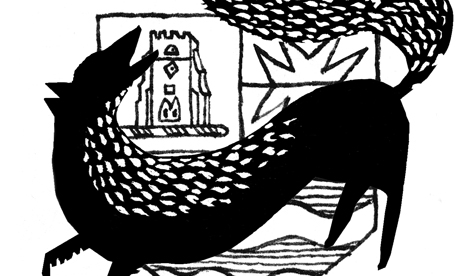
The year we’ve just toasted out was one of drama, triumph and loss for Hackney.
Gentrification proceeded apace with average rents rising to upwards of £2,000 a month and over 900 households officially recognised as homeless. Developers developed, politicians politicked and life went on.
The borough was rocked by year-long epic tussles over the proposed high-rise development at the Bishopsgate Goodsyard site in Shoreditch and two new cycle routes.
The kerfuffle over the Bishopsgate scheme kicked off in February when Hackney Mayor Jules Pipe launched a campaign to ‘save Shoreditch’ from a quartet of towers – up to 48 storeys in height – that were backed by his City Hall counterpart, Boris Johnson.
Though the campaign succeeded in shaving a storey or two off some of the worst-offending structures, Hackney Council proved powerless to block the development. Cynics were suspicious of the Hackney Mayor’s motives, noting that his authority had rubber-stamped a number of other high-rise schemes under its control. And astute Citizen readers will recall Hackney approving a 51-storey version of the Bishopsgate scheme back in 2010.
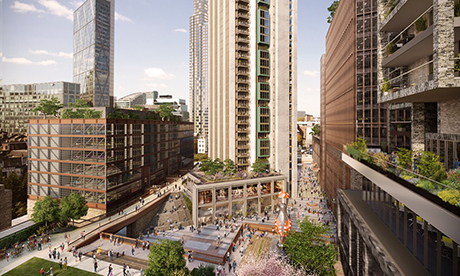
Final proposals: following consultation and amendments, the latest designs for the development. Image: Hammerson
Closer to the ground but no less contentious was another plan backed by Mayor Johnson: a cycling ‘superhighway’ from Tottenham to central London. The Hackney portion of the scheme became embroiled in controversy as the residents of the areas affected – Stamford Hill, Stoke Newington, Dalston, De Beauvoir and Hoxton – debated possible alternatives. A second cycle route through London Fields also aroused local ire in the autumn when it came to light that the council had failed to carry out an appropriate consultation, and ended up having to backpedal on the measure.
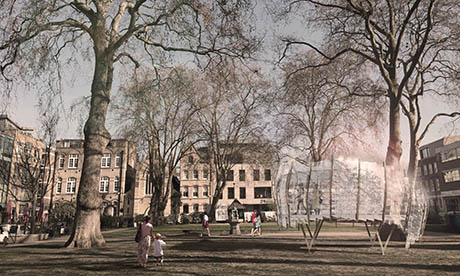
Branching out: the tree office in Hoxton
In Dalston it was the end of an era, as a much-defended Georgian terrace on Dalston Lane was finally sold off to developers and plans were mooted for the redevelopment of the area around Ashwin Street, the Eastern Curve Garden and Ridley Road Market.
But if Hackney’s architectural heritage is under threat, some interesting innovations also popped up in the borough last year. A wooden skyscraper was given the go-ahead on Dalston Lane, and Hackney’s first eco-friendly Passivhaus was built in Lansdowne Drive. The search for useable indoor space gave London Fields a prefab rooftop house and Hoxton an office in a tree. The area is still desperately short of housing, however, prompting a petition demanding Hackney Council lodge homeless people in its underused premises.
Polling and culling
On the national stage, 2015 was General Election year. Local political actors dutifully played their allotted parts in the ritual spring panto: local artists ran parliamentary-campaigns-as-performance-art; the borough’s electoral register suffered ‘glitches’ that disenfranchised dozens of prospective voters; and MPs Diane Abbott and Meg Hillier got themselves re-elected for Hackney North and South respectively.
May also witnessed a heroic display of community solidarity as local residents rallied round the homeless when they discovered the council had criminalised street drinking, begging and rough sleeping in an area around London Fields.
The Public Space Protection Order (PSPO) – soon dubbed ‘Linden’s Law’ after its architect Deputy Mayor Sophie Linden – had been snuck in without consultation, shocking many members of Linden’s own party. The order was hastily withdrawn amid community uproar.
A similar saga was played out several miles to the west in Clissold Park, where the object of the council’s cleansing spree was the local fox population.
And as with ‘Linden’s Law’, opposition triumphed, pushing the authorities to abandon their vulpine cull.
On the environmental front, we got a smidgen greener with the launch of Hackney Energy solar start-up. The Arcola Theatre also installed a carbon-neutral hearting system.
A debate on fossil fuel divestment at the same theatre put pressure on the council to reconsider its investment in oil, gas and coal. Perhaps most welcome by locals was the opening of a new nature reserve at the East Reservoir in Stoke Newington.
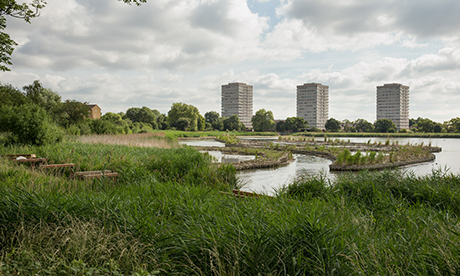
East Reservoir in Stoke Newington
Meanwhile in hipsterdom…
Hackney’s most journalistically dissected indigenous species was subject to attack at Cereal Killers café in Shoreditch and Well Street Pizza. It was also the recipient of an apology from the fire brigade following a sardonic tweet noting that ‘thankfully no hipsters were injured’ in a fire. GCHQ has been virtually alone in wooing the creatures, through pavement recruitment ads.
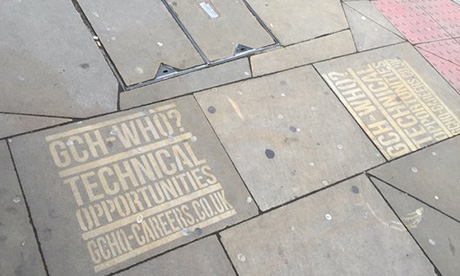
From GCHQ With Love: recruitment adverts designed to attract Shoreditch tech-heads. Photograph: James Cook
Going up in 2015
• The borough’s Latin American community: awarded official recognition as an ethnic group
• Elizabeth Adekunle: appointed archdeacon of Hackney
• Eels in the river Lea: flourishing at last
• Diane Abbott: back in the Labour shadow cabinet as shadow international development secretary
• The Joiners Arms, Chesham Arms, Prince Edward, Rose and Crown and Stag’s Head pubs: all preserved for community use
• Soil from Hackney Marshes: dug up and transported to the Tate Modern for an earthy art exhibition
And down
• Iconic Hackney Road venues Mecca Bingo and the George and Dragon gay pub: closed
• Studio space for artists and musicians in Cremer Street, Holborn Studios and Wallis Road in Hackney Wick: threatened with redevelopment
• Sainsbury’s: pulled out of Wilmer Place development following a protracted campaign by residents
• Joshua Bonehill: Jailed for inciting racial hatred with his protests against the ‘jewification’ of Stamford Hill
• The topmouth gudgeon of Clissold Park: decimated by council piscicide
• The Hackney electoral register: lost a quarter of its entries as duplicates and non-registrants culled
In memoriam
Michael Leslie Gray
Akis Kollaros
Moshe Yitzchok Greenfield
Joe Lobenstein
Jack Susianta
Jeremie Malenge
Marcel Addai
Moses Fadairo
Jerome Scott
Sabri Karatas
